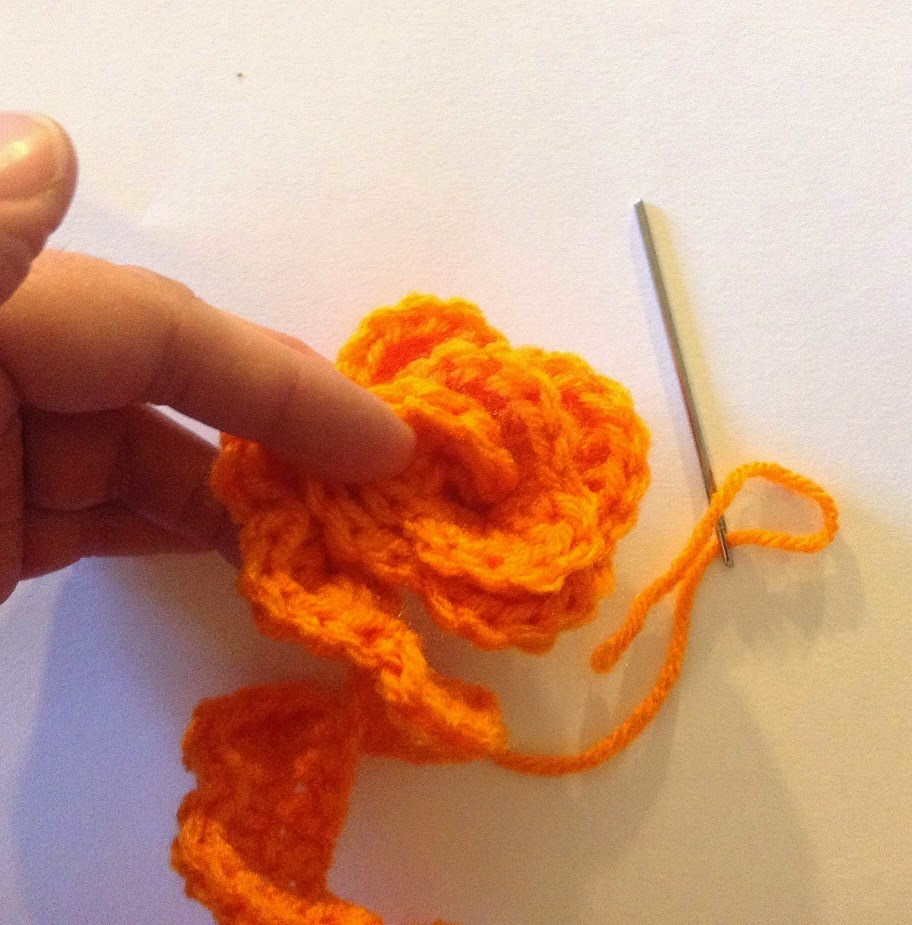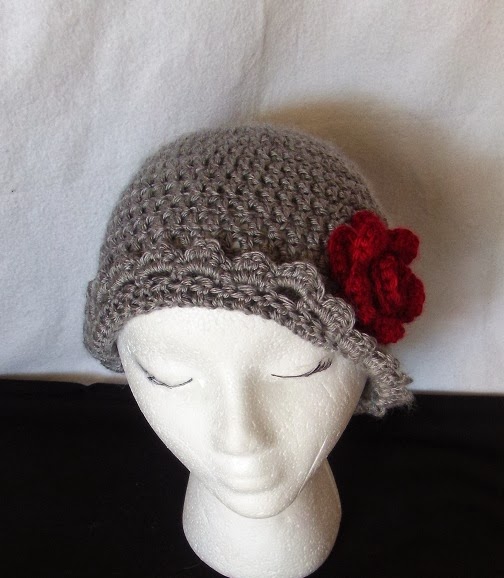Free instructions: How to crochet Red Heart Sashay ruffle scarf 2 different ways
Please do not copy, sell or offer these patterns as your own. Please share a link to my blog here for other's to find my free patterns, in doing so, I am able to offer more free patterns to everyone.
I recommend watching my youtube.com video before completing either pattern included here, for additional tips and tricks to help you while creating your scarf. You can view both knit and crochet versions here:
http://www.youtube.com/user/YvetteMarieCrafts
Notes:
A. Normally, using a different size hook or pair of knitting needles, will not make a difference in your work. The holes are already created for you to work with, so when you cast on, you are not concerned with being a tight or loose crochet/knitter. It does not really matter, I recommend the hook size below, because it is what I have found to work well in a comfortable manner, for each of the patterns in the way it is worked up.
B. When working with this particular ruffle yarn/fabric (there are a more than a couple brands on the market), if you find a knot in your yarn/fabric as you are working it, you can do one of 2 things: (either one you choose, you will normally not see it once your scarf is complete!) 1. You can work right over the knot as if it were not there….or…. 2. You can usually, untie the knot, and overlap the fabrics (one facing one direction and one facing the other), so that you have 2 layers crisscrossing, and work right through them following the pattern as if it were a normal layer.
Tips for working your patterns:
There are a couple things you will do with both versions.
Step 1: (use for both versions), at the beginning of both versions, tie a knot in the end of your yarn/fabric leaving about ½ inch tail. Don’t trim too close, as it can unravel a little easier when washing, leaving a short tail is more secure. It will not show when your scarf is completed. (See next photo)
Both versions, you will be working into every other hole/loop. This gives you the ruffle effect that you won’t get if you crochet or knit into every single hole/loop. I use the very top row to work my stitches. Some people ignore the top row of stitches, and use the second row from the top to work into. Personally, I just use the first, top row to work my stitches. (Notice the difference in the top that you work with and the bottom or border of the yarn/fabric. (See next photo)
I highly recommend only hand washing or hand swishing in a basin/sink with some gentle soap, wring gently in a towel to remove excess moisture and line/air dry only. This will keep your scarf looking as new as possible longer, with normal wear and tear.
No Crochet-Crochet version (this version works up very quickly and is great for beginners and children!)
Hook size K (recommended for this version)
Recommended # of stitches to cast on between 8-10. Not a lot of difference, 8 stitches will be a little bit skinnier version and 10 a little chunkier.
In this version you can get 2 scarves at a decent length, using the whole skein for one scarf will result in a super long scarf, which you may prefer :0)
Also, this is a very forgiving pattern…if you miscount, and do 8 instead of 10 for one row (when you were working with 10 all along), you will never notice! Don’t worry about going back for a re-do on that row, just keep working. Use step 1 above
Step 2: fold over 4 holes/loops to back of fabric (this will be hidden in the end)
Step 3: “Cast on” stitches to be worked in the following manner: working from front to back, insert crochet hook in first stitch (will be doubled fabric from step 2 for only a couple stitches). * Skip a stitch, and pick up the following stitch from front to back (so you will bring your crochet hook up over the fabric in a sweeping motion to the front, and pick up the next stitch *. Repeat from * to * to cast on the number of stitches desired (8-10).
Step 4: Keeping only the first stitch closest to the hook end, pull that first stitch through the remaining stitches on the hook (including the doubled layer at the other end of the hook). You will now only have one stitch left on the hook. You have completed the first “row” of your scarf. (Notice in the following photo, how the last 3 stitches farthest away from the hook are layered in 2, this is from the folded portion at the beginning of the pattern).
Step 5: Cast on another row in the following manner: skip the first hole/loop again, and pick up the next one as you did in step 3, from front to back. Skipping every other hole, cast on # of stitches you started with (ex: 8-10…if you started with 8 stitches, you will now cast on another 7 to make a full row of 8, etc.)
Step 6: Once you cast on your row, follow step 4 again. (The following photo is after 5 or 6 rows).
For the rest of the scarf, you will follow Row 4 and Row 5, consecutively until you reach the length desired. Again, if you use the whole skein, your scarf will probably reach the floor. If you choose to make a shorter version, you can make a nice scarf with about ½ of the skein at a time. Make one for you, and one for a friend! :0)
To end your scarf: after completing your last row and leaving about 4-6 inches of yarn, you will have 1 loop left on your hook. Take the remaining tail of the yarn and pull it through the loop on your hook. Tie a secure/tight knot as close to the loop (on top of the loop is better) you just pulled it through and snip off excess leaving about ½ inch for a secure finish. If you are hand-washing and line drying, which I highly recommend, this will be a very secure method of ending your scarf.
If you would like to see an easy quick video tutorial for this finishing method, click here:
https://www.youtube.com/watch?v=mtfPl-YoeYw
“Real” Crochet ruffle scarf
(I do recommend some crochet experience with this version, however, watching my youtube.com video mentioned above, can be very helpful if you are a beginner for this scarf.)
You will use a full skein for one scarf.
For this version, you will actually create rows of “stitches” back and forth that you will work in a similar fashion to real crocheting with normal yarn where you crochet a row, turn your work, and then crochet the next row, etc. This version will be fuller than the first version above and more like the knitted version. Hook size N, or you can use a smaller hook, like K. Make sure to not pull too tightly on your yarn as you work it, you want to have loose holes to find and work into easy. Follow step 1 (for both versions)
Step 2: fold over 4 holes/loops to back of fabric (this will be hidden in the end) (see photo in first pattern version)
Step 3: Casting on will be the same as the first version, “Cast on” stitches to be worked in the following manner: working from front to back, insert crochet hook in first stitch (will be doubled fabric from step 2 for only a couple stitches). * Skip a stitch, and pick up the following stitch from front to back (so you will bring your crochet hook up over the fabric in a sweeping motion to the front, and pick up the next stitch (making sure to skip one) *. Cast on 3 stitches in this manner. (Next photo shows the 3 stitches, one hidden in hook)
Step 4: Pull first 2 loops closest to end of hook through last loop farthest away from end of hook. You will now only have 1 loop left on hook.
Step 5: Repeat this 4 more times… skipping a hole with the working yarn, add a loop to the existing loop on the hook, skip a loop and add a second loop to the hook, now you have 3 loops on the hook. Pull the first 2 loops closest to the end of the hook through last loop farthest away from the end of hook. The following photos show me pointing to the 5 stitches you have just created that you will be working in to as you create them each row you work back and forth. I have separated the yarn a bit so you can see the stitches clearly that were created. Get to know the look of these stitches, you will use them every row.
Step 6: You will now create a chain one (Note: you will create a chain 1 at the end of every row before you turn your work). To create a chain 1, skip the next loop on the working yarn, and insert hook into the following loop, and pull that loop (closest to the hook) through the other loop on the hook. You have now created a chain 1
Step 7: Turn your work, meaning, turn your already worked row around, you are now going to work into those 5 stitches in the individual photos in step 5. The working yarn will be behind the row you are looking at, so you can easily access it to use.
Note: When completing the next row and each subsequent row, try not to pull the yarn too tight, as it makes it more difficult to find the stitches you are going to work into for each row as you turn your work.
Step 8: Insert hook into the first stitch, closest to the hook. Skip one loop from the working yarn, and put the next loop on the hook. You now have 3 loops on the hook (see photos…1st photo shows my chain 1 and then my work turned ready to work back down the row, 2nd photo I am pointing at the chain 1 from before you turned your work and now it is on the hook with the other 2 loops, 3rd photo I am pointing at the stitch from the worked row that you are working back down, and 4th photo I am pointing at the loop you just brought over your hook from the working yarn from the skein (it is white yarn in the photo, may be a little more difficult to see this one).




Next, pull the loop closest to the hook only through the middle loop. Do not bring it through both loops yet. Now, you have 2 loops on your hook. Now, skip a loop from your working yarn on the skein, and place the next loop on your hook. Again, you have 3 loops on your hook. Now, bring the loop closest to the hook through both of the other 2 loops on the hook. You now have 1 loop on the hook. You have just basically, worked one single crochet (if you can call it that, with this yarn). You are now going to repeat all of step 8 for each of the 4 remaining stitches across the row. Make sure you skip a stitch when you insert your hook into the next loop and draw up that first loop from the working yarn and again pulling up the 2nd loop from the working yarn. This will keep things comfortable, and not too tight, and it will create your ruffle nicely.
Step 9: Repeat this process for the entire skein of yarn/fabric. When you get near the end of the skein, make sure you have at least 4-6 inches for your finishing. You do not have to work a full row before finishing, if you happen to work ½ a row, and you have the 4-6 inches needed to finish, you can complete the “end your scarf” directions from this point.
To end your scarf: after completing your last row and leaving about 4-6 inches of yarn, you will have 1 loop left on your hook. Take the remaining tail of the yarn and pull it through the loop on your hook. Tie a secure/tight knot as close to the loop you just pulled it through and snip off excess leaving about ½ inch
for a secure finish. If you are hand-washing and line drying, which I highly recommend, this will be a very secure method of ending your scarf.
If you would like to see an easy short video tutorial on how to end finish your ruffle scarf, please click here:
https://www.youtube.com/watch?v=mtfPl-YoeYw
Congratulations! You have now finished one of the crochet versions of the ruffle scarf!






























































